Abstract
Within a time frame of about ten years, experimental
(interactive) media installations and performances have gained
recognition as new art forms in public space. Artworks explore the
interconnectedness of public space, interaction, and new media.
Urban Screens investigates how the growing infrastructure of
dynamic digital displays in urban space, currently dominated by
commercial forces, can be utilized in this context and broadened
with cultural content. The research project wants to network and
sensitize engaged parties for possibilities of using the digital
infrastructure for contributing to a lively urban society. The
integration of current information technologies supports the
development of a new digital layer of the city in a fusion of material
and immaterial space, redefining the function of this growing
infrastructure. Interactivity and participation will bind the screens to
the communal context of the space and thereby create local identity
and engagement.
Figure 1: New York Times Square: accumulation of LED boards.
Photo: Louis Brill. 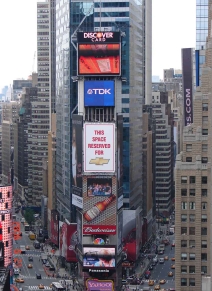 The Redefinition of a Growing
Infrastructure The Redefinition of a Growing
Infrastructure
Public space is the city's medium for
communication with itself, with the new and unknown, with the
history and with the contradictions and conflicts that arise from all
those. Public space is urban planning's moderator in a city of free
players. [1]
Prof. Wolfgang Christ, 2000
How can the growing digital display infrastructure
appearing in the modern urban landscape contribute to this idea of
a public space as moderator and as communication medium?
The mobilization of digital technology and a growing
digital culture have changed the urban communication
environment. In the context of the rapidly evolving commercial
information sphere of our cities, various new digital display
technologies are being introduced into the urban landscape:
daylight compatible LED billboards, plasma screens exposed in
shop windows, beamboards, information displays in public
transport systems, electronic city information terminals,
holographic screen projections, or dynamic and intelligent surfaces,
integrated into architectural facade structures. [Fig. 1]
As McQuire has put it, "The migration of electronic screens
into the external cityscape has become one of the most visible
tendencies of contemporary urbanism." [2] Considering this
already existing digital infrastructure, it is a great challenge to
broaden the use of these "moving billboards," as Lev
Manovich calls them in his vision of an Augmented Space [3],
instead of flooding urban space with new techno-objects.
So far one of the main targets of this infrastructure is
to manage and control consumer behavior. We are not far away
from the implementation of technology that makes it possible to
cover buildings with large flexile planes of moving images,
networked and controlled from one central location but making use
of site-specifically collected consumer data. Display systems
already start to detect our behavior and adjust to our consumer
preferences.
Paul Virillio sees the new, developing "pervasive
architecture-style" of screens covering high-rise-facades as
"Electronic Gothic." [4] He refers to the narratives of
Gothic church windows, which where aimed at effecting people's
moral behavior. Immersion and its effects on the audience will also
be increased by the "perfect" incorporation of screens in
the architecture of the urban landscape.
How can the use of these screens controlled by market
forces be broadened and culturally curated? Initiatives such as
Locomotion, Going Underground, Strictly Public, Outvideo, the 59th
Minute and Transmedia :29:59 [5] are pioneering in their use of
commercial outdoor displays for screenings of video art. New
balanced alliances are needed that challenge city authorities and
regulators, architects, advertisers and broadcasters, as well as
cultural curators, artists, and the citizen as producer – joint
cooperations to shape the future development of the "screen
world" in a sustainable manner, considering the danger of
visual and technological pollution of urban space. [Fig. 2]

Figure 2. The range of screens in urban public space.
Urban Screens are defined as various kinds of dynamic
digital displays in urban space that are used in consideration of a
well balanced, sustainable urban society – screens that
support the idea of public space as space for creation and exchange
of culture, or the formation of a public sphere through criticism and
reflection. Their digital and networked nature makes these
screening platforms an experimental visualization zone on the
threshold of virtual and urban public space.
The Broader Context of Urban
Screens
Urban public space – understood as open, civic space
– is a key element in the development of European urbanism.
In this role as space for representation, culture, and encounter
through trade, exchange and discussion, urban areas have always
been a place that is rendered alive through various interactions.
Referring back to the old concept of the Greek Agora, urban public
space is a unique arena for exchange of rituals and communication.
A constant process of renewal and negotiation challenges the
development of urban society. The architectural dimension of urban
space has played an important role in providing a stage for these
interactions. Moreover, the architecture itself functions as a
medium, telling narratives about the city, its people, and the
represented structure of society. Its inhabitants can read the
reoccurring social interactions and the way the space is populated
in a participatory process. The whole urban structure is becoming
the crystallization of the city's memory over time.
Yet, the vanishing role of public space as place for
social and symbolic confrontation and discourse has been much
discussed in urban sociology over the last century. Sennett,
Häussermann, and Bott, in particular, have pointed out how,
since modernization, individualization and a growing independence
from place and time seem to have destroyed the old rhythms of the
city and therefore its social systems. We currently face a transitional
period of the restructuring of social networks and discover new
relations among people and places in a globalized world that is
threatened by diffuse and complex fears of instability and lack of
strong local roots. This situation has resulted in various
experiments with new types of relations, supported by developing
new media tools.
In its early stages, the Internet was discovered as new,
alternative public sphere. The rediscovery of a civic society is tied to
the inherent structure of the Internet, which is strongly based on
cooperative exchange and shared engagement through the
openness of systems. The population of virtual spaces –
virtual cities with their chat rooms, MUDs, and experimental spaces
for creating alternative identities – has been continuously
growing. Now we are looking at various experiments with
community in the growing field of social computing – peer-
to-peer networks, friend-of-a-friend communities such as Orkut or
Friendster, and, more recently, mobile communities connecting
mobile phone users. We also find participatory experiments in
content creation within the mailinglist culture and wiki and
blogging systems, serving an increased need for self-expression.
Now these explorations of virtual worlds have merged with the
rediscovery of urban public space, the recent popularity of locative
media being one indicator of this development.
In parallel, an "event culture" has evolved in
the real urban space. Guy Debord already foresaw "the society
of the spectacle" in 1967, and his critique of a society
"in which the individuals consume a world fabricated by
others rather than producing one of their own, organized around
the consumption of images, commodities, and staged events"
[6] should be taken seriously. In the growing international
competition among cities, the focus often is on tourism or the
citizen as consumer. City marketing and urban management
strategies are applied to create a vision of "creative
cities" that are in fact not necessarily supporting the
inhabitants' creative use of the city or their creative contribution to
a lively urban culture. Cities are engaged in a struggle with a
"feeling of placelessness" caused by the spread of
international architecture and branded shops. In fact, screens also
tend to look the same everywhere, so there is a need to consider
the locality as well as site-specifity of the content in order to
prevent further disconnection of the perception of our urban space
from the actual locality.
In order to maintain the social sustainability of our
cities, it is important to take a closer look at the livability and use of
urban public space and the rediscovery of a civic society. The
information platform www.interactionfield.de gives an overview of
numerous interactive media projects, assessing their potential for
urban society in terms of:
Promoting interaction, fearless confrontation and
contact with strangers
Promoting formation of public sphere by criticism,
reflection on society
Promoting social interaction and integration in the local
neighborhood
Supporting understanding of the current development of
our high-tech society
Supporting conscious participation in the creation of
public space [7]
Urban Screens can be understood in the context of a
reinvention of the public sphere and the urban character of cities,
based on a well-balanced mix of functions and the idea of the
inhabitant as active citizen instead of properly behaving consumer.
Virtual spaces alone cannot function as spaces for exchange and
production of identity.
The Character of Urban
Screens
In connection with the ephemeral yet open character of the
digital information world, Urban Screens asks for a new urban
language with its own dynamic signs and symbols, formed through
active participation from various players. New interactive
technologies and networked media offer more possibilities for the
visual programming of these digital surfaces through the interplay
of new display technologies, broadcasting tools, database and
content management systems, and sensor technology. Linda
Wallace sees "the internet as a delivery mechanism to inhabit
and or change actual urban spaces." [8]
Through the the Internet and other digital networks,
digital content has become more fluid, being, at least in theory,
available anytime, anywhere, produced for the audience of the new
global village. Could large outdoor displays function as
experimental "visualization zones" of a fusion of virtual
public spaces and our real world? Can we localize the huge flows of
information through these screens, and can these zones in fact play
a more active role, more active than just providing the canvas on
which the digital world is rendered? What characterizes Urban
Screens is a connection to the locality of the static nature of the
new screening infrastructure.
In contrast to the mobile screens integrated in phones,
PDAs, laptops etc., which display content for an individual, Urban
Screens focuses on the public urban audience, on joint and
widespread reception of media content. The growing
embeddedness in screen systems, accessibility of information via
Internet, mobile devices, etc. augments the respective urban space's
"situatedness." Levels of locality and globality vary,
ranging from the local neighborhood screens with symbols and
signs on a city level to trans-urban networks of screens enabling
new "glocal" interconnectivity.
Figure 3. Soccer game on the BBC Big
Screen in Manchester.
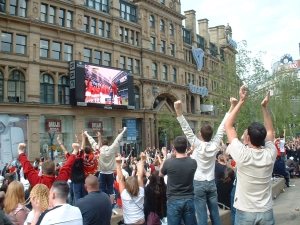 Visions of New Content and Use Visions of New Content and Use
The first steps in broadening the commercial
advertisement content of large digital outdoor screens focused on
the transfer and slight adjustment of TV features to the new
circumstances of public viewing. Soon we might have TV broadcast
stations specialized in urban public space and its local community.
The experiments done by BBC in collaboration with Philips and local
City Councils in various cities in the UK could be considered a
forerunner to these TV broadcast stations. They coordinated
outdoor movie-screenings, the collective watching of soccer-
games, and special City-TV news channels. [Fig. 3] Preferably set up
in key locations, in a setting for a wider audience, these screenings
in memorable places could support identification with local culture
through joint experiences. A local memory could indeed develop, if
the screens were used as a means for maintaining and supporting a
rich and complex local culture.
There has been a growing interest in connecting screening
infrastructure with cultural institutions that preserve and produce
digital content or video art. Cultural centers and institutions such as
the Schaulager in Basel and Austria's Kunsthaus Graz have started,
in a more experimental style, to officially integrate screens in their
architectural facades, so that they function as an extension of their
archives into public space. The Australian Centre for the Moving
Image uses the nearby public screen in Federation Square,
Melbourne. The Creative Industries Precinct (Australia's first site
dedicated to creative experimentation and commercial development
in the creative industries, located on the western fringe of
Brisbane's Central Business District) integrated three screens in its
complex of buildings to address different audiences. [Fig. 4] One of
the screens will be used to support the development of a new local
community in the vicinity. The above mentioned BBC project of
Public Space Broadcasting on community screens collaborates
extensively with local art institutions.
Figure 4. Orientation of the 3 screens
at the Creative Industries Precinct.
Sketch by Peter
Lavery. 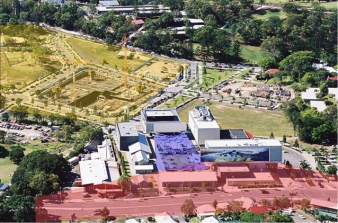 A new audience can be reached on their daily routes
by bringing content into outdoor public space. Connecting Urban
Screens amongst each other could enable new mechanisms for
creating and maintaining relationships between cross-cultural
organizations and their audiences. A new audience can be reached on their daily routes
by bringing content into outdoor public space. Connecting Urban
Screens amongst each other could enable new mechanisms for
creating and maintaining relationships between cross-cultural
organizations and their audiences.
Connected screens could also serve as exchange
platform between the inhabitants of various cities. A repeatedly
suggested idea for using these screens is to enhance the
connectivity of remote communities through shared visual displays
that utilize videoconferencing. These connections between remote
spaces reflect the relativity of the terms "close" and
"remote" in a globalized world and an increasingly
transnational lifestyle. Hole In Space (1980), one of the early
projects of this kind connected the people walking past the Lincoln
Center for the Performing Arts in New York City with people in the
Broadway department store in Century City (LA) through life-sized
television images. The project Hole in the Earth
(2003-2004) linked the audience in Rotterdam with people in
Indonesia on the other side of the world through screens, camera,
and microphones in an installation resembling a well. [Fig. 5]
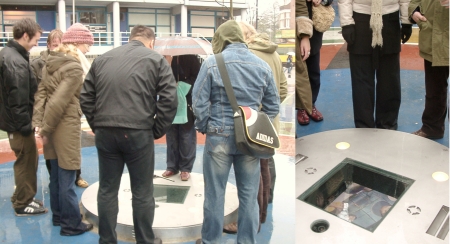
Figure 5. Opening of the installation Hole in the
Earth by Maki Ueda, Rotterdam, December
2003.
In Russia, China, USA, and South America large
networks are currently developing on a city as well as national level.
Screens become a key element in the government, regional, and
urban informational infrastructure due to their ability to easily
convey and spread content in local spaces.
The appeal of a local environment obviously is a highly
subjective matter, but a sophisticated social interaction and
information network in a local neighborhood could play an
important role in the perception of locality, supporting a feeling of
security. By connecting large outdoor screens with experiments in
online worlds, the culture of collaborative content production and
networking could be brought to a wider audience and serve as an
inspiration.
Interactive screens integrated into urban furniture
similar to a blackboard for comments, stories, conversations, could
also help to circulate and access data, serving and strengthening
the local community and its small-scale economy.
In 1997, Philips already was involved in a large research
project called LIME (Living Memory), which integrated
a local exchange platform into café tables and other urban
furniture. Following this early example, various projects aimed at
further developing the idea of interactive community boards and
supporting the information exchange in a local community are
currently being produced. [9]
In an attempt to address issues of fear in urban spaces,
Rude Architecture implemented a network of Chat Stops equipped
with interactive video technology, enabling communication between
people waiting at different bus stops. If they desired, people could
start a "video conference" with others waiting
somewhere else. By means of communication with other
inhabitants, the boredom of waiting could be alleviated through
conversations, and subjective feelings of safety could potentially be
increased. The project applies video communication instead of
video surveillance – voluntarily and transparent, but at the
same time entertaining.
The mobile phone can also be utilized as information
transmitter. Various artists have rediscovered the idea of the urban
dialogue in the form of speaker's corners and have been
experimenting with the use of SMS for public expression. The
project Storyboard by Stefhan Caddick used a mobile
Variable Message Sign situated in public space to display submitted
SMS text. Will the next step be to connect the
"blogosphere" to Urban Screens? What strategies will
prevent misuse and encourage high-quality submissions?
Involving an urban audience in experiments requiring
participatory planning and making use of the participatory tools of
new media is a great challenge. Screens in public spaces could
function as mediation board between the community and the local
planning department and serve as a public display for the exchange
of ideas.
Jeanne van Heeswijk's project Face Your
World – which took place in Columbus, Ohio, in 2002
– gave children on a bus access to a multi-user computer
game allowing them to redesigning their communities as they
envisioned them. [Fig. 6] At three bus stops, the creations were
displayed on special screen sculptures presenting the results of the
game to the urban community. As van Heeswijk put it, "It's
about the way people look at the space around them. With
everything being privatized now, people don't view the community
as their own any more." [10] In this case, digital media were
utilized as interaction catalysts for the participation and
engagement of young people in a local community.
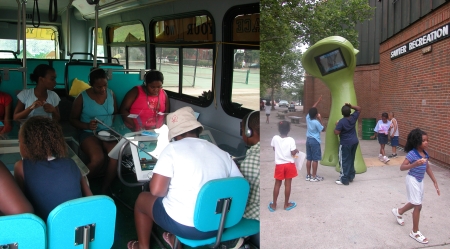
Figure 6. Face Your World: involving young
kids in community planning.
Conclusion
Content needs to be coordinated with new visions of how,
when, and in what specific locations screens can be integrated in
the urban landscape and its architecture. The balance between
content, location, and type of screen determines the success of the
interaction with the audience and prevents noise and visual
pollution. Furthermore, we need to understand how the growing
infrastructure of digital displays influences the perception of our
public spaces' visual sphere.
Whenever we integrate a medium into the city's public
space, we need to assume responsibilities regarding the
sustainability of our urban society. Public space is the glue that
holds urban society together. It is time to shape future directions of
the developing "screen world" in a sustainable manner.
It is time to develop more creative visions for alternative, socially
oriented content for various types of Urban Screens and to avoid a
focus on technology. Other forces than merely commercial interests
should drive the attempt to shape the future development of the
emergent "screen world." [11]
Mirjam Struppek
Urban Media Research, Berlin
http://www.interactionfield.de
struppek@interactionfield.de
References:
[1] W. Christ, "Public versus private Space," IRS
international symposium, Die europäische Stadt - ein
auslaufendes Modell? (Erkner bei Berlin, Germany, March
2000).
[2] S. McQuire, "The Politics of Public Space in the
Media City" in Urban Screens: Discovering the potential of
outdoor screens for urban society, First Monday Special Issue
#4 (February 2006), http://www.firstmonday.org
[3] Lev Manovich, "The Poetics of Augmented
Space" (2002),http://www.manovich.net/DOCS/augmented_spac
e.doc
[4] P. Virilio, "We may be entering an electronic
gothic era" in Architectural Design - Architects in
Cyberspace II, Vol. 68 No. 11 / 12 (Nov. / Dec. 1998), pp.
61-65.
[5] For a list of artistic screening events and initiatives
see http://www.urbanscreens.org
[6] S. Best, D. Kellner, The Postmodern
Turn (Guilford Press: New York, NY, 1997), p. 82.
[7] For a detailed description of these developed
categories see http://www.interactionfield.de
[8] L. Wallace, "Screenworld" in Material
media, artefacts from a digital age (2003), http://www.machinehunger.com.au/phd/pdf
?
[9] E. Churchill et al. "Multimedia fliers:
information sharing with digital community bulletin boards" in
Huysman, Marleen et al. (eds.) Communities and
technologies (Kluwer, B.V.: Deventer, 2003), pp. 97-
117.
[10] van Heeswijk cited in J. Gentile, "Exhibit to
unite community," The Lantern Issue 6/27/02,
Arts Section (2002), http://www.thelantern.com
[11] For a detailed article presenting various Urban
Screens projects, see M. Struppek, "The social potential of
Urban Screens" in Screens and the Social Landscape,
Visual Communication, Vol. 5, No. 2 (Sage Publications, June
2006), pp. 173-188.
|

